Reproduction of violets
Content:
Undoubtedly, violets are stunning flowers, and no one would refuse to grow them on their window. However, people are interesting creatures: even when they get what they want, they start wanting it even more. And, since violets are so adorable and beautiful, why not see more of their cute and beautiful flowers on your windowsill every day? In addition, it means expanding the collection, new varieties and new experiences. And also, of course, a new experience of caring for a significantly larger number of plants at the same time. In any case, solving the problem of wanting to possess a large number of colors can be quite simple. For a violet, this solution, however, is rather unclear, and novice flower growers may not even have heard of it, but experienced and hardened ones already perfectly understand what is at stake. True, we will touch on such a topic as the propagation of violets by a leaf, which, by the way, has been recognized by experienced breeders and flower growers as the best and most effective method for propagating this lovely flower.
In addition, it should be noted that it is very simple, and therefore absolutely everyone can master it, if, of course, he wants to. It also offers a fairly high germination rate and low financial costs, and therefore leaf propagation of violets is better than buying seedlings or seeds in all respects.
In this article, we will tell you exactly how this procedure is carried out, and how you can carry it out correctly, without harming the mother plant and getting wonderful shoots that will soon turn into wonderful flowers.
Reproduction of violets by a leaf: Detailed instructions
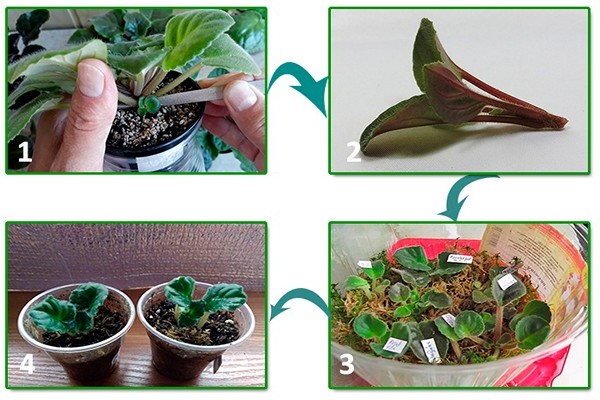
leaf propagation of violets
Despite the fact that, as we said earlier, this operation is incredibly simple and intuitive, it still contains a number of nuances and subtleties that you should definitely know.
Choosing the time of the operation
Of course, it is best to propagate violets by a leaf at a time when all other serious procedures are carried out on plants, namely, in summer or spring. It is at this time that the plant will be best prepared to tolerate the procedure painlessly and recover in speed. In addition, this timing will also allow the sprouts to prepare well for winter.
However, it is not always possible to carry out the procedure at a suitable time. For example, in the event that the plant is on the verge of death, and you need to save it, but, unfortunately, it is already deep winter outside.
Naturally, you have nothing left but to start breeding, but you should understand that any procedures in winter are a big risk, and therefore the chances that everything will go smoothly, of course, are reduced.
However, all this is relevant for you in the event that you have not yet gained experience. A wise and trained florist can easily carry out such a delicate procedure in absolutely any weather.
Which sheet to choose?
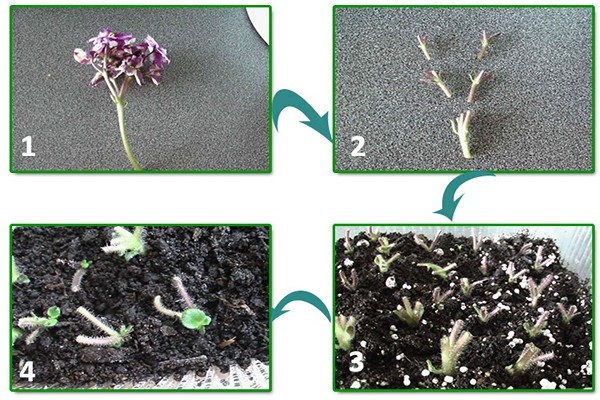
violets home breeding
Of course, no procedure will go smoothly if you select the wrong sheet, since this is where at least half of its success lies. We believe that it is quite obvious that a weak or diseased leaf simply will not give the desired effect, and therefore the larger, healthier and stronger the planting material you choose, the better the reproduction of violets will occur.
In order not to be mistaken with the choice, it is advisable to choose the right stems on which they grow. The fact is that, for example, on the lower stems, which constantly grow in the shade of their upper neighbors, of course, nothing worthwhile will grow.
In addition, for an hour it is on the lower stems that all old and unusable leaves remain, therefore, of course, you need to choose the leaf that most often sees the sun during the day - the one that grows higher.
However, this does not mean that the topmost leaf is always the best and only correct choice. In the end, the selection process must be approached wisely, and therefore, if, for example, on the second or third tier of stems there is a much more suitable specimen, why not take it?
By the way, there is one more rule. We strongly recommend that you use only those leaves that have grown on your violet... The ones that appeared on the flower in the store where you bought your plant are likely to be weak, drooping and unusable due to the fact that the flowers there simply do not have such good care that you can provide at home.
In addition, the leaf can be significantly damaged on the way to your home, although you will not see any noticeable physical injury. However, if you simply do not have a choice, and you want to take leaves from a drooping plant and bring out a new healthy generation from them, it is advisable to steam the weak leaves in hot water.
This is done for no more than two hours, since otherwise everything may not go as planned, and the leaves will simply become unusable.
By the way, it is highly recommended to add potassium permanganate to the water, since without it there is a high probability of bacteria, viruses or fungi entering the seedlings, which can disrupt your entire procedure in the bud.
After steaming, it is recommended to dry the leaf on a dry cloth. Now that he is completely ready for planting, you should prune his stalk a little. It is advisable to leave so much length from it that only four centimeters remain to the base of the sheet. The cut angle, however, does not matter.
Reproduction of violets in water: Rooting a leaf
This method is also very common, but it implies that you will act quickly and immediately. The faster the leaf gets into the water, the better your chances of breeding will be successful.
However, it still remains the simplest and most recommended for beginners, since it, in the event that the reproduction of violets takes place in boiled or settled water, offers you the following advantages:
You always know in what state the planting material is, and you can also determine for sure if something bad happens to it and you will quickly react by saving your seedlings.
It will also help you to prevent the possible entry of fungus into the plant, which, if infected, can cause rot and death of the seedlings.
In addition, you will be able to watch in real time how the root system of the leaf is formed, and how it turns into a poor violet, which will soon become a wonderful decoration for your home.
However, there are very strict rules that are associated with this method, and violation of these rules can lead to the death of the leaf, and, accordingly, the inability to carry out the procedure further.
First of all, it is very important to rinse and disinfect well the container in which the shoot will grow. If we are talking about disposable dishes, then it is completely desirable to completely sterilize it in order to exclude any possibility of harmful compounds and bacteria getting into the leaf.
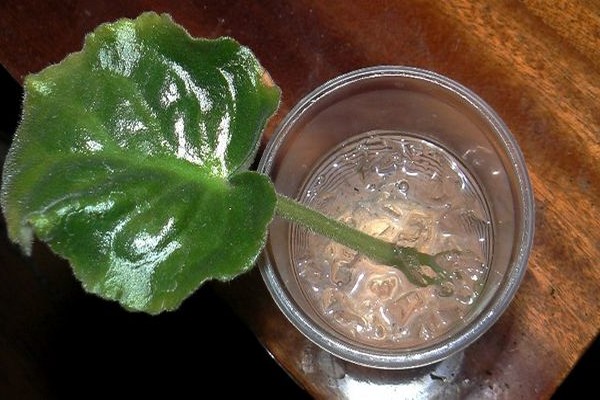
photo: Reproduction of violets in water
However, we still do not recommend that you take risks and choose disposable dishes: they are simply unreliable, and therefore it is much better to choose some kind of time-tested glass made of as dark glass as possible. Such a remarkable quality will not allow green algae to form on the surface of the water and pollute it, and, accordingly, will not interfere with the growth and development of our leaf.
A slight deepening of the leaf cutting into the soil, which will provide it with greater safety and preservation. Nevertheless, the deepening should not be excessive, and therefore two centimeters will be sufficient.
While the leaf is in a vessel with water, its cut should not touch the walls. The fact is that this is the most delicate and sensitive part of a young plant, and therefore any effect on it can lead to unpleasant consequences. In order to prevent unwanted contacts, you can use the fastening with a sheet of paper or a piece of cardboard.
So that certainly no diseases can attack your leaf while it is in the water, we highly recommend that you throw a tablet of activated carbon into the container of your choice.
You must be prepared for the moisture to gradually evaporate from the surface of the liquid, and therefore it will need to be added over time. Nevertheless, when carrying out such pouring, you need to be very careful, since if the water touches the leaf itself or, on the contrary, it is not enough, the leaf may die.
In order to root the leaf, after you put this method into action, you will need to follow this plan, which implies:
Before the roots start to appear, of course, you have to wait. Of course, there simply does not exist a definite time for a leaf to stay in water, since one must take into account the huge number of varieties and species that are cultivated in our time.
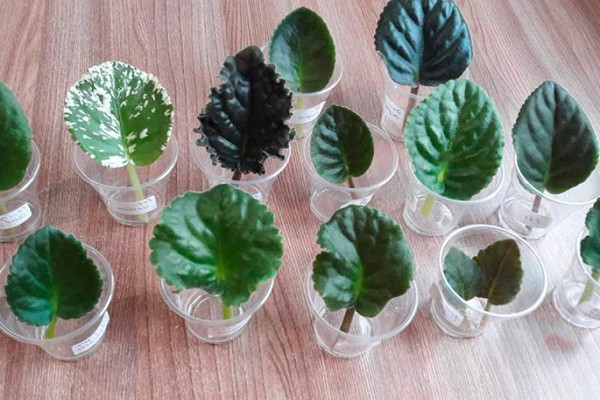
photo: Reproduction of violets in water
Nevertheless, if we try to find the average value, we will get about two to four weeks of waiting before you see the first roots growing from the cutting of your leaf.
However, unfortunately, during the procedure, things may not go as smoothly as you would like, and the leaf may develop rot. In this case, you should not hesitate and urgently get the seedlings from the container with water. After that, it is very carefully dried and part of the stalk with rot is completely removed.
After that, you can try to carry out the procedure again, however, the water, of course, is completely replaced, and an activated carbon tablet is thrown into the new one, which will not allow rot to appear again.
Coal, by the way, for greater confidence, you can also rub the place of the cut. Most likely, if you did everything correctly and quickly enough, the roots will nevertheless begin to form, and as soon as they reach a length of one to two centimeters, they can be taken out of the water and placed in the ground, where they will grow in the near future.
Nevertheless, in some cases, pulling a leaf out of the water when it has roots is not the best solution. In this case, experienced flower growers are waiting for a small rudiment of a rosette to appear on the sprout.
However, 0 should be warned that if you are a beginner, determining when it will be better to get the sheet early and when - later, will be an incredibly difficult task for you, which we recommend that you leave it on the shoulders of the professionals. In any case, if the leaf already has roots, it will definitely not die in the ground. Of course, if you take good care of him.
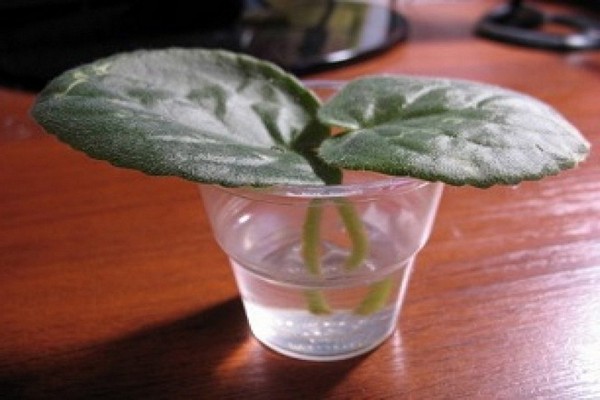
However, before proceeding with watering and, in principle, care, you should select a suitable container for the sprout. Unlike the previous stage, when our leaf was in water, you can already use disposable dishes at this stage.In addition, it is more convenient, since a drainage hole can be easily made in the plastic cup.
However, the hole alone will not be enough to ensure the leaflet has a good drainage of water, and therefore the glass needs to be filled by about a third with small pebbles, and soil is placed on top of it almost to the very edges.
As for the planting procedure itself, it is quite simple, but it still requires a certain accuracy and delicacy from you. First of all, you need to dig a small hole. However, you need to calculate its size so that the plant is not too deep. As already mentioned, two centimeters is quite enough, well, more is too much.
The reason for such a small deepening is simple: if you plant the leaf deeper, the socket formed underground simply cannot break through to the surface and will be suppressed by the layer of soil that is above it.
After successful planting, the soil around the cutting needs to be compacted a little so that it stands firmly in the pot without wobbling. You also need to make the first careful watering, after which the improvised pot is either placed in the greenhouse or covered with a bag, thanks to which a mini-greenhouse effect and a favorable atmosphere for the successful growth of the plant are created.
Of course, if you propagate several varieties at once, it is very desirable to sign the pots, since in the early stages of development, different violets are very similar to each other and it is almost impossible to distinguish them from each other, which can create a huge number of problems in the future.
When should you get the plant out of the greenhouse / remove the bag from it? Usually it needs to be kept in this state for no more than two weeks, since it is this time that is most often enough for the leaf to grow enough to rise above the ground level.
How to root a violet in potting mix?
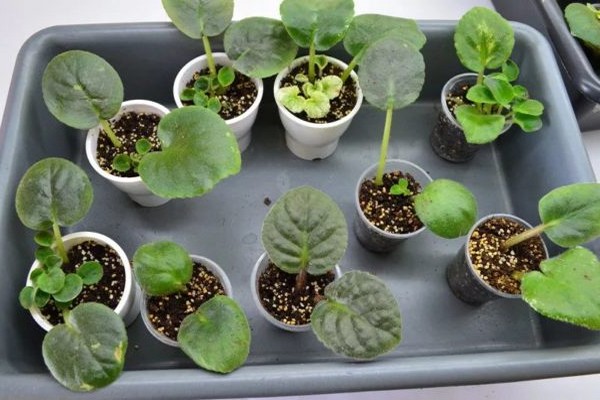
This procedure has a very good effect on the future development and growth of the plant, since it is in a good soil mixture that the leaf and its roots show their best side.
In addition, this method will most likely allow you to solve the problem that the leaf that you initially chose was a little painful and weak. It is in a well-prepared ground that he will "get a second wind" and a second chance will appear.
In order to crank this procedure, you will need to follow approximately the same instructions as in the previous case, however, the stalk will need to be rooted even more, leaving not four, but only one and a half centimeters. This is especially true for miniature varieties.
For planting, you can prepare exactly the same cup that we prepared for transplanting violets growing in water into the ground.
However, you can also use an ordinary pot. Its volume should be about a hundred milliliters, and its diameter should not exceed five centimeters.
As in the previous method, we fill a third of the total volume with drainage in order for the plant to feel more comfortable with stagnant water. In the event that you use expanded clay as a drainage material, you should thoroughly disinfect it, since the chance of developing a fungal infection will not be small.
Almost the entire remaining volume of the pot is filled with soil. You need to make a small hole in it, into which our cutting will be placed. This recess, which will already be inserted by the handle, is not filled with simple soil, but mixed and very loose. This is done so that the small rosettes that form at the roots have a better chance of breaking through the soil and not being buried under the lean soil.
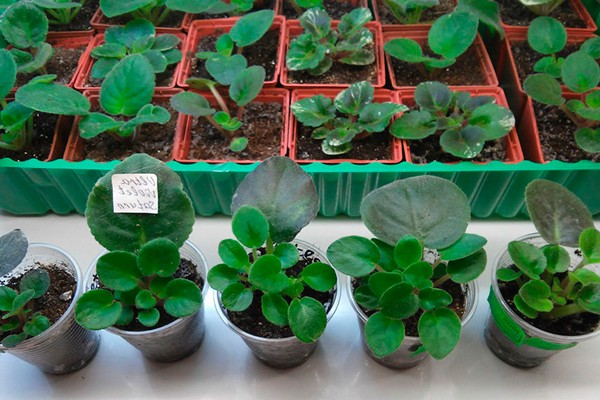
Sometimes, however, you can find instructions that suggest that you completely fill the pot with just such loose soil, however, in our opinion, this can be extremely detrimental to your plant, especially if you have not yet had time to gain experience.
The fact is that such loose soil, obviously, retains moisture rather poorly, and therefore you will have to greatly increase the frequency of watering, which in the end will definitely not lead to anything good.
In order for the soil, on the contrary, to be good, rich and useful, you will need to add a little sphagnum moss to it, which is responsible precisely for retaining moisture. In addition, this moss is antibacterial, which makes it an excellent additional protection for your plant.
When you plant a cutting, the soil should already be slightly damp. However, the deepening should be very small, since, despite the fact that we use very loose soil, it will be incredibly difficult for young roots to break through it, and therefore there is no need to deepen the cutting by more than five millimeters.
Nevertheless, if the leaf and the stalk itself are large enough, this depth can be increased up to a centimeter. In addition, even several sheets can be planted in one glass at once, but this also requires certain skills, and we do not advise you to do this if you are not at a sufficient level.
By the way, in order to more clearly look at how all these procedures are carried out, we strongly recommend that you watch the videos related directly to the propagation of violets by a leaf. This way, you can even better consolidate the information you received while reading this article.
And again, as in the previous case, if the roots of your leaves have more or less formed, the soil around them can be slightly compacted and moistened, and the glass with the plant is placed in the greenhouse. However, as you remember, you can cover it with a bag.
However, keeping them in this state is not very useful, since in such a humid environment there is a huge risk of mold formation, and therefore the seedling, both in the greenhouse and under the bag, needs to be ventilated.
Reproduction of violets by a leaf in a peat tablet
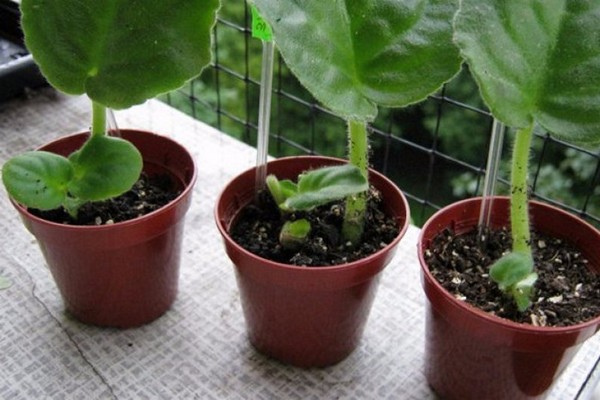
This is our last, but not least, method. The fact is that, despite the fact that it is relatively unpopular, it still remains very effective and efficient, and therefore, if you have already tried other methods, you can experiment and use a peat tablet.
The conditions created with this wonderful potting mix will not only allow the violet rosette to break through the soil with ease, but will also provide it with ample nutrients and will also perfectly retain moisture and prevent rot.
Let's sum up
In order for the procedure for propagating violets by the leaf method to be successful, you will need to provide the plant with some of the conditions listed below so that you can repeat all the most important aspects mentioned in this article.
First of all, of course, you need a fairly loose, but at the same time, well-retaining soil, which will allow your leaf to grow without any difficulties. Mixed soil can also be used.
It is equally important to maintain an optimal room temperature between twenty-two and twenty-six degrees Celsius. A greenhouse or an ordinary plastic bag can help you with this.
It is necessary to provide the sprout with a sufficiently long daylight hours, thanks to which it will be able to receive enough energy to grow and develop effectively.
Watering should be not only regular, but also with correctly calculated portions, since only in this way can you help the plant get used to new conditions and maintain an optimal growth rate.
The place where you grow the leaf should be humid enough. Otherwise, there is a high probability that the plant will dry out and, most likely, die, not having time to turn into a wonderful adult.
It is equally important to find a good place to grow your seedlings, and therefore, if you have racks for plants on which you can place several pots at once, you can do nothing better than placing your violets there.
Ideal potting mix
After reading all of the above points, you probably noticed that one of the most important, if not the most important part of a violet leaf propagation is good soil. Therefore, we strongly recommend that you make it yourself, as what you buy in the store may not be good enough and will not meet your expectations.
The preparation of the soil should be started a few days before the direct planting of the boring in the pot, since all the ingredients need to be thoroughly mixed with each other. As a basis, we advise you to use not ordinary soil, but ready-made soil for violets, which can be freely purchased in any store or market.
Nevertheless, since experienced gardeners do not like to use at least something purchased, we can recommend them the following recipe, with which you can prepare not only healthy, but also natural potting mix:
You will need one part of deciduous humus, three parts of high-moor peat, one part of clean river sand, two parts of sphagnum moss and one part of ordinary garden land, which will not be difficult to find at all.
Also, to provide soil looseness, you can use substances such as, for example, perlite, which have become especially popular and widespread in recent years.
Also, it will not be superfluous to introduce crushed charcoal into the soil, which will provide your sprout with protection from viruses, bacteria and fungi, and, of course, a little sphagnum moss on top to maintain a sufficient moisture content in the soil after watering.
In the event that you have already used sphagnum to make the base of the potting mix, you will have to grind it. But as a whole, it can be used even in the form of drainage.
Separation of outlets during leaf propagation
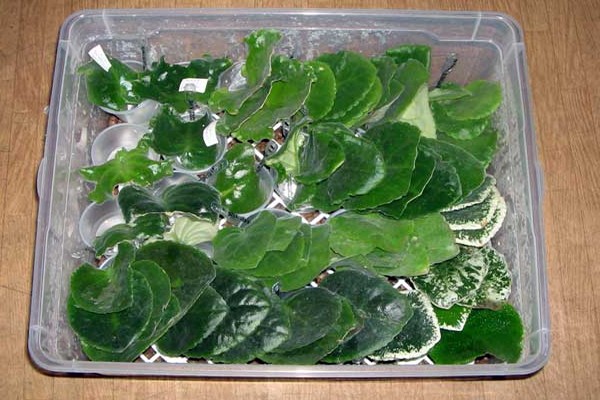
The fact is that in all the previous paragraphs, considering pots and cups for growing seedlings, we, of course, talked exclusively about a temporary dwelling, since these plants grow quite quickly.
Soon enough, several young outlets will form underground, and then the question of where and how to put them will become quite acute.
To resolve this issue, the usual transplant procedure is used, however, you should take into account that if the leaves have a slightly unhealthy color, in no case should they be transplanted. It also means that they need to be taken care of a little more diligently, and then in a few weeks everything will return to normal.
If you are going to cut the rosettes, then you need to take into account that each of them must have at least a couple of leaves, and preferably three, so that each plot can easily support its own existence through photosynthesis.
It is also worth remembering that separation is a rather exhausting procedure for a plant, and therefore it must be carried out not only carefully, but also observing the following rules:
The soil must be very well moistened so that a "warm welcome" is given to the new pot.
The plant must be transplanted together with a lump of earth, since otherwise you run a very high risk of damaging its root system.
Pots, by the way, of course, should be tiny. In diameter, they may not even reach five centimeters, however, while the plots are just growing and gaining strength, these sizes should be more than enough for them.
However, a very unpleasant situation can happen during the plot: some children will simply not have enough roots to maintain normal life.In this case, you will need to make the soil for them as loose as possible. Also, after planting, it is advisable to plant such a painful sprout in a greenhouse.
After some time, when the diameter of the plant is twice the diameter of the pot itself, you can think about transplanting the flower to a permanent place of residence, where you can take care of it like a full-fledged adult plant. The pot, accordingly, should also be enlarged, but the violet leaves should still be slightly larger than it.
Otherwise, the final transplant before entering adult violet life is no different from what you have already done.
Conclusion
Propagating violets without having to go to the store for saplings or seeds is incredibly helpful if you want to become a good and skillful grower. Just think how much your collection can grow if you ever try such a reproduction of violets.
Well, our task is to help you easily cope with all the difficulties that await you along the way, and it seems to us that we coped with it perfectly. All that remains is to wish you good luck.

